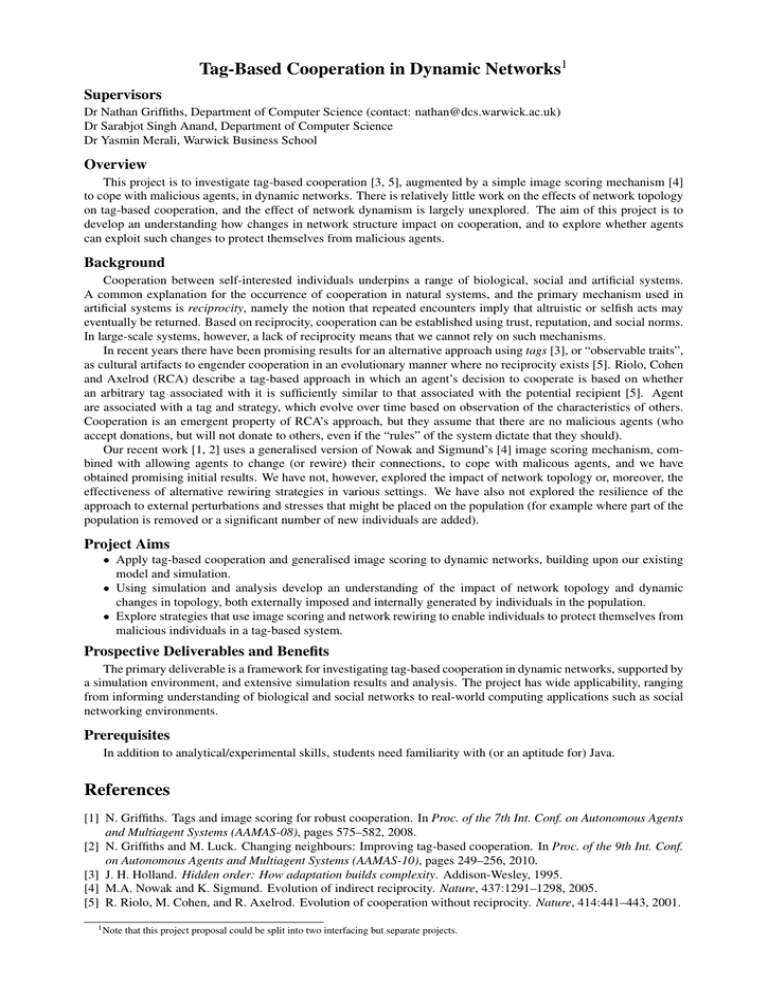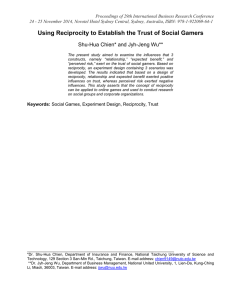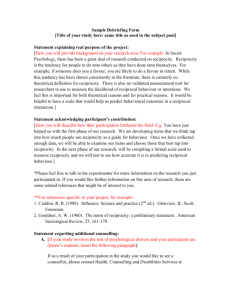Tag-Based Cooperation in Dynamic Networks Supervisors
advertisement

Tag-Based Cooperation in Dynamic Networks1 Supervisors Dr Nathan Griffiths, Department of Computer Science (contact: nathan@dcs.warwick.ac.uk) Dr Sarabjot Singh Anand, Department of Computer Science Dr Yasmin Merali, Warwick Business School Overview This project is to investigate tag-based cooperation [3, 5], augmented by a simple image scoring mechanism [4] to cope with malicious agents, in dynamic networks. There is relatively little work on the effects of network topology on tag-based cooperation, and the effect of network dynamism is largely unexplored. The aim of this project is to develop an understanding how changes in network structure impact on cooperation, and to explore whether agents can exploit such changes to protect themselves from malicious agents. Background Cooperation between self-interested individuals underpins a range of biological, social and artificial systems. A common explanation for the occurrence of cooperation in natural systems, and the primary mechanism used in artificial systems is reciprocity, namely the notion that repeated encounters imply that altruistic or selfish acts may eventually be returned. Based on reciprocity, cooperation can be established using trust, reputation, and social norms. In large-scale systems, however, a lack of reciprocity means that we cannot rely on such mechanisms. In recent years there have been promising results for an alternative approach using tags [3], or “observable traits”, as cultural artifacts to engender cooperation in an evolutionary manner where no reciprocity exists [5]. Riolo, Cohen and Axelrod (RCA) describe a tag-based approach in which an agent’s decision to cooperate is based on whether an arbitrary tag associated with it is sufficiently similar to that associated with the potential recipient [5]. Agent are associated with a tag and strategy, which evolve over time based on observation of the characteristics of others. Cooperation is an emergent property of RCA’s approach, but they assume that there are no malicious agents (who accept donations, but will not donate to others, even if the “rules” of the system dictate that they should). Our recent work [1, 2] uses a generalised version of Nowak and Sigmund’s [4] image scoring mechanism, combined with allowing agents to change (or rewire) their connections, to cope with malicous agents, and we have obtained promising initial results. We have not, however, explored the impact of network topology or, moreover, the effectiveness of alternative rewiring strategies in various settings. We have also not explored the resilience of the approach to external perturbations and stresses that might be placed on the population (for example where part of the population is removed or a significant number of new individuals are added). Project Aims • Apply tag-based cooperation and generalised image scoring to dynamic networks, building upon our existing model and simulation. • Using simulation and analysis develop an understanding of the impact of network topology and dynamic changes in topology, both externally imposed and internally generated by individuals in the population. • Explore strategies that use image scoring and network rewiring to enable individuals to protect themselves from malicious individuals in a tag-based system. Prospective Deliverables and Benefits The primary deliverable is a framework for investigating tag-based cooperation in dynamic networks, supported by a simulation environment, and extensive simulation results and analysis. The project has wide applicability, ranging from informing understanding of biological and social networks to real-world computing applications such as social networking environments. Prerequisites In addition to analytical/experimental skills, students need familiarity with (or an aptitude for) Java. References [1] N. Griffiths. Tags and image scoring for robust cooperation. In Proc. of the 7th Int. Conf. on Autonomous Agents and Multiagent Systems (AAMAS-08), pages 575–582, 2008. [2] N. Griffiths and M. Luck. Changing neighbours: Improving tag-based cooperation. In Proc. of the 9th Int. Conf. on Autonomous Agents and Multiagent Systems (AAMAS-10), pages 249–256, 2010. [3] J. H. Holland. Hidden order: How adaptation builds complexity. Addison-Wesley, 1995. [4] M.A. Nowak and K. Sigmund. Evolution of indirect reciprocity. Nature, 437:1291–1298, 2005. [5] R. Riolo, M. Cohen, and R. Axelrod. Evolution of cooperation without reciprocity. Nature, 414:441–443, 2001. 1 Note that this project proposal could be split into two interfacing but separate projects.




